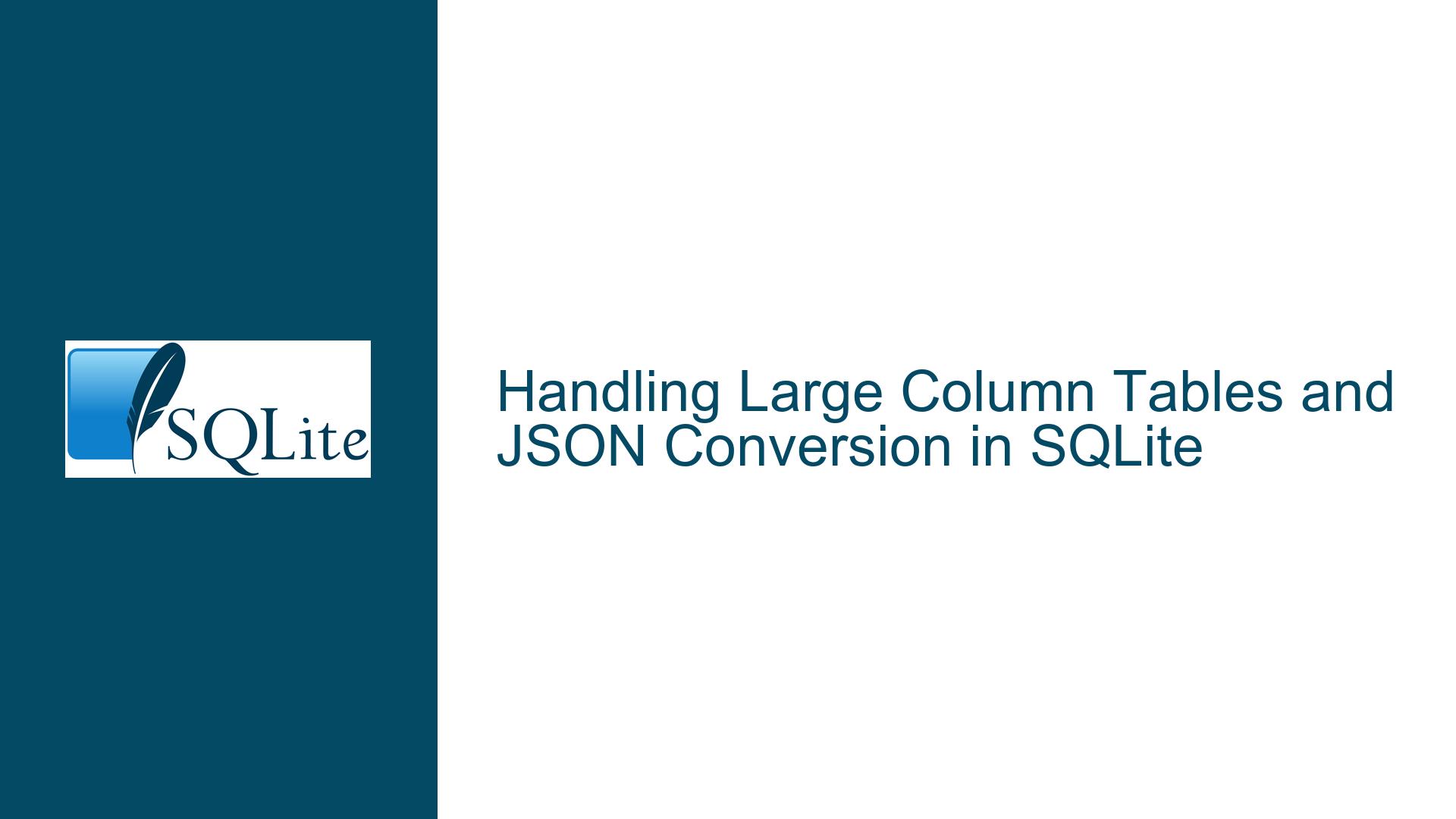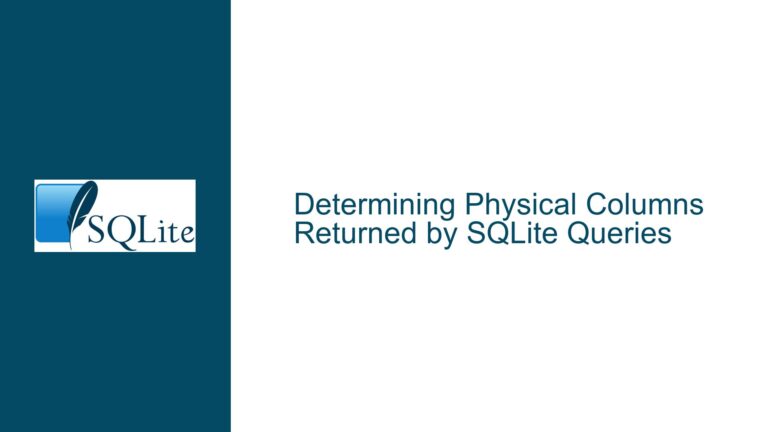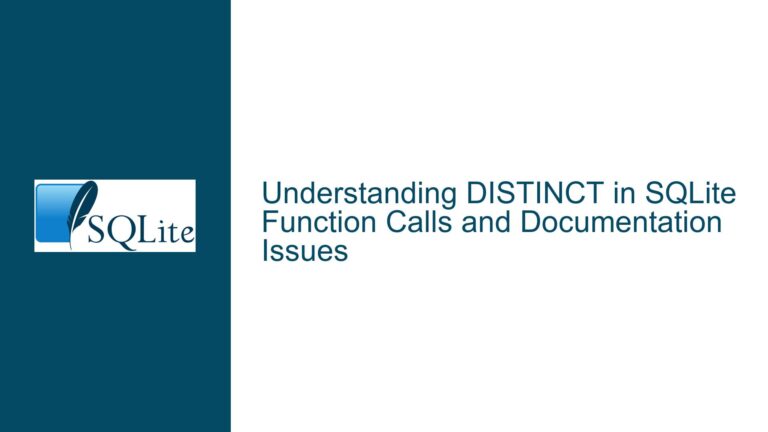Handling Large Column Tables and JSON Conversion in SQLite
Issue Overview: Converting SQLite Query Results to JSON with Large Column Counts
The core issue revolves around the need to convert SQLite query results into JSON format, particularly when dealing with tables that have a large number of columns (exceeding 63 columns). The current SQLite JSON functions, such as json_group_array and json_object, are limited by the number of parameters they can accept, which becomes problematic when attempting to convert rows from tables with many columns into a JSON array of objects. This limitation hinders the ability to seamlessly integrate SQLite with modern web applications and APIs that often expect data in JSON format.
The discussion highlights the desire for a feature similar to those found in other databases like MS SQL and PostgreSQL, where query results can be directly formatted as JSON using constructs like FOR JSON or functions like row_to_json. These features simplify the process of converting tabular data into JSON, making it more efficient and less error-prone, especially when dealing with large datasets or tables with many columns.
Possible Causes: Limitations in SQLite’s JSON Functionality and Parameter Handling
The primary cause of the issue lies in SQLite’s inherent limitations regarding the number of parameters that can be passed to a function. Specifically, the json_object function, which is used to construct JSON objects from SQL rows, has a parameter limit that restricts its use with tables that have more than 63 columns. This limitation is due to the way SQLite handles function calls internally, where the number of arguments is capped to prevent excessive memory usage and potential performance degradation.
Another contributing factor is the lack of built-in support for direct JSON formatting of query results in SQLite. While SQLite provides robust JSON support through its JSON1 extension, it does not offer a straightforward way to convert entire query results into JSON format without manually specifying each column. This manual process becomes cumbersome and impractical when dealing with tables that have a large number of columns, as it requires extensive and error-prone SQL scripting.
Additionally, the discussion touches on the potential for implementing this functionality through SQLite extensions. However, extensions are limited in their ability to modify SQLite’s syntax, making it challenging to introduce new constructs like FOR JSON directly into the SQL language. This limitation further complicates the issue, as it restricts the ability to enhance SQLite’s JSON capabilities without significant changes to the core database engine.
Troubleshooting Steps, Solutions & Fixes: Workarounds and Best Practices for JSON Conversion in SQLite
To address the issue of converting SQLite query results to JSON, especially for tables with a large number of columns, several workarounds and best practices can be employed. These solutions aim to mitigate the limitations of SQLite’s JSON functions and provide more efficient ways to handle JSON conversion.
1. Using Subqueries and Common Table Expressions (CTEs):
One approach to overcome the parameter limit of the json_object function is to break down the query into smaller, manageable parts using subqueries or CTEs. By splitting the query, you can construct JSON objects for subsets of columns and then combine them into a final JSON array. This method reduces the number of parameters passed to the json_object function at any given time, thereby avoiding the parameter limit.
For example, consider a table myTable with over 100 columns. Instead of attempting to convert all columns at once, you can divide the columns into groups and construct JSON objects for each group separately. The final JSON array can then be assembled by combining these individual JSON objects.
WITH subset1 AS (
SELECT json_object('col1', col1, 'col2', col2, ..., 'col63', col63) AS json_obj
FROM myTable
),
subset2 AS (
SELECT json_object('col64', col64, 'col65', col65, ..., 'col126', col126) AS json_obj
FROM myTable
)
SELECT json_group_array(json_obj) AS json_array
FROM (
SELECT json_obj FROM subset1
UNION ALL
SELECT json_obj FROM subset2
);
This approach allows you to handle tables with a large number of columns by processing them in smaller chunks, thus avoiding the parameter limit of the json_object function.
2. Leveraging SQLite’s JSON1 Extension Functions:
SQLite’s JSON1 extension provides several functions that can be used to manipulate JSON data. While these functions do not directly solve the issue of converting large column tables to JSON, they can be used in combination with other techniques to achieve the desired result.
For instance, the json_each and json_tree functions can be used to extract data from JSON objects and arrays. These functions can be particularly useful when dealing with nested JSON structures or when you need to extract specific values from a JSON column.
However, it’s important to note that these functions are more suited for working with existing JSON data rather than converting tabular data to JSON. Therefore, they should be used in conjunction with other methods, such as subqueries or CTEs, to achieve the desired outcome.
3. Implementing Custom JSON Conversion Logic in Application Code:
In cases where SQLite’s built-in JSON functions are insufficient, it may be necessary to implement custom JSON conversion logic in the application code. This approach involves fetching the query results from SQLite and then converting them to JSON programmatically using a programming language such as Python, JavaScript, or Java.
For example, if you are using Python with the sqlite3 module, you can fetch the query results as a list of tuples and then convert them to a JSON array using the json module. This method provides greater flexibility and control over the JSON conversion process, allowing you to handle tables with any number of columns without being constrained by SQLite’s parameter limits.
import sqlite3
import json
# Connect to the SQLite database
conn = sqlite3.connect('myDatabase.db')
cursor = conn.cursor()
# Execute the query
cursor.execute("SELECT * FROM myTable")
rows = cursor.fetchall()
# Convert the query results to a JSON array
json_array = []
for row in rows:
json_obj = {column[0]: value for column, value in zip(cursor.description, row)}
json_array.append(json_obj)
# Output the JSON array
print(json.dumps(json_array, indent=2))
# Close the connection
conn.close()
This approach allows you to bypass SQLite’s limitations entirely by handling the JSON conversion in the application layer. However, it does require additional code and may introduce some overhead, especially when dealing with large datasets.
4. Exploring Third-Party Libraries and Tools:
Another potential solution is to explore third-party libraries and tools that provide enhanced JSON support for SQLite. These libraries often extend SQLite’s functionality by offering additional features and capabilities, such as direct JSON formatting of query results.
For example, the sqlite-utils library in Python provides a convenient way to work with SQLite databases and includes utilities for converting query results to JSON. This library simplifies the process of fetching data from SQLite and converting it to JSON, making it easier to handle tables with a large number of columns.
from sqlite_utils import Database
# Connect to the SQLite database
db = Database('myDatabase.db')
# Fetch the query results as a list of dictionaries
rows = db['myTable'].rows
# Convert the query results to a JSON array
json_array = list(rows)
# Output the JSON array
print(json.dumps(json_array, indent=2))
Using third-party libraries can significantly reduce the complexity of JSON conversion and provide a more streamlined workflow. However, it’s important to evaluate the reliability and performance of these libraries before integrating them into your application.
5. Advocating for Native JSON Formatting Support in SQLite:
While the above solutions provide workarounds for the current limitations, the most effective long-term solution would be for SQLite to introduce native support for direct JSON formatting of query results. This could be achieved through the addition of new SQL constructs or functions that simplify the process of converting tabular data to JSON.
For example, SQLite could introduce a FOR JSON clause similar to that found in MS SQL, allowing users to specify that the query results should be returned as a JSON array of objects. This would eliminate the need for manual JSON conversion and provide a more efficient and user-friendly way to handle JSON data in SQLite.
SELECT * FROM myTable FOR JSON AUTO;
Advocating for this feature within the SQLite community and contributing to the development of such functionality could lead to significant improvements in SQLite’s JSON capabilities, making it more competitive with other databases that already offer similar features.
Conclusion:
Converting SQLite query results to JSON, especially for tables with a large number of columns, presents a unique set of challenges due to the limitations of SQLite’s JSON functions and parameter handling. However, by employing a combination of subqueries, CTEs, application-level JSON conversion, third-party libraries, and advocating for native JSON formatting support, it is possible to overcome these challenges and achieve the desired outcome.
Each of the proposed solutions has its own advantages and trade-offs, and the best approach will depend on the specific requirements and constraints of your application. By carefully evaluating these options and implementing the most suitable solution, you can effectively handle JSON conversion in SQLite and ensure seamless integration with modern web applications and APIs.






